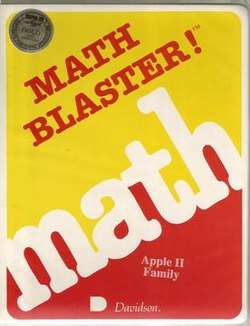Math Blaster!
| Math Blaster! | |
|---|---|
 Apple II Cover art | |
| Developer(s) | Davidson & Associates |
| Publisher(s) | Davidson & Associates |
| Designer(s) | Janice G. Davidson, Richard K Eckert Jr.[1] |
| Platform(s) |
Original: DOS, Windows |
| Release |
1983 (Original) 1987 (Plus) 1990 (New Plus) |
| Genre(s) | Educational |
| Mode(s) | Single-player |
Math Blaster! is a 1983 educational video game, and the first entry in the Math Blaster series within the Blaster Learning System. The game was developed by former educator Jan Davidson.[2] It would be remade and re-released a number of times starting with Math Blaster Plus! and followed by New Math Blaster Plus. A complete makeover over was done for Math Blaster Episode I: In Search of Spot in 1993.
The game eventually spawned other Math Blaster games and spin-offs such as Alge Blaster, Reading Blaster and Math Blaster Mystery: The Great Brain Robbery.
Gameplay
An arcade-style educational game that offers skill-building mathematical exercises, The title contains minigames that test players' knowledge in subjects such as particular addition, subtraction, multiplication, division, fractions, percentages, and decimals. A series of mathematics problems appear on the screen, and the player must move to fire the cannon pointing at the correct answer. The game included an editor for teachers and parents to design their own problems.
While this title was purely a drill and practice, its 1987 sequel would wrap the activity around a narrative.[3]
Educational Goals
Math Blaster was designed to aid students to master mathematics grades 1 till 6 in an exciting and interesting manner. The learning activities were graphically-appealing in motivating and challenging students.[1]
Commercial performance
After it was developed, Math Blaster! was extensively tested in classrooms.[1] By November 2, 1985, the game had sustained 92 weeks on the Billboard charts for Top Education Computing Software, and was currently at #2. The game, plus its various sequels and spin-offs, has since become the best-selling piece of maths software in history.[4]
Critical reception
InfoWorld praised the game for its high resolution graphics, and considered it a standout title in the drill-and-practice edutainment video game genre, and deemed it a perfect teache's aid primary school classroom use.[5]
The game inspired a series of maths problem solving games that would become a popular series in the marketplace.[6] Along with Reader Rabbit and The Oregon Trail, the game is considered a classic.[7]
References
- 1 2 3 "Math Blaster! Educational Software that Works". Retrieved June 26, 2017.
- ↑ Ito, Mizuko (2012-02-10). Engineering Play: A Cultural History of Children's Software. MIT Press. ISBN 9780262291552.
- ↑ Becker, Katrin (2016-10-04). Choosing and Using Digital Games in the Classroom: A Practical Guide. Springer. ISBN 9783319122236.
- ↑ Ito, Mizuko (2012-02-10). Engineering Play: A Cultural History of Children's Software. MIT Press. ISBN 9780262291552.
- ↑ Inc, InfoWorld Media Group (1983-07-11). InfoWorld. InfoWorld Media Group, Inc.
- ↑ Jr, Eugene F. Provenzo; Brett, Arlene; McCloskey, Gary N. (2004-09-22). Computers, Curriculum, and Cultural Change: An Introduction for Teachers. Routledge. ISBN 1135627088.
- ↑ Ito, Mizuko (2012-02-10). Engineering Play: A Cultural History of Children's Software. MIT Press. ISBN 9780262291552.